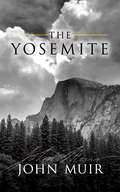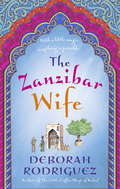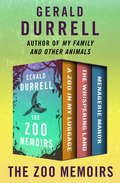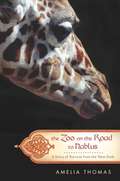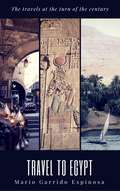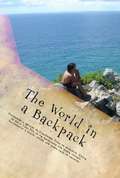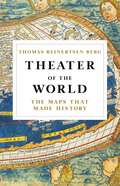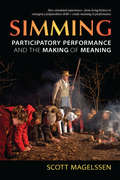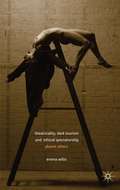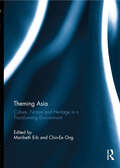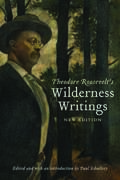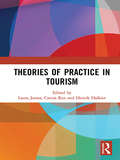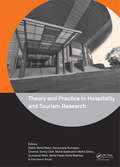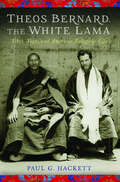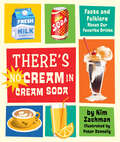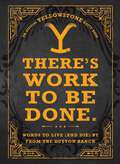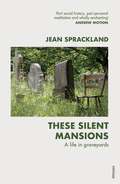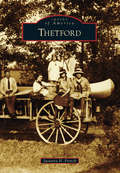- Table View
- List View
The Yosemite: Illustrated Edition (Mobi Classics Series)
by John MuirAn essential companion for visitors, this book by the famed conservationist offers informed appraisals of Yosemite's plant and animal life and exudes an almost mystical love for its natural beauty.
The Young Investigator's Guide to Ancient Aliens
by History ChannelAs a tie-in to the wildly successful History Channel show, here's a book filled with fascinating tales, ancient folklore, and compelling evidence of the role extraterrestrials may have played in human history. What really happened to the dinosaurs? Who actually built the ancient pyramids in Egypt? Are airplanes really as modern as we think they are? This book takes a close look at landmark events throughout history and asks the question: What if aliens were involved? Spanning history, from the earliest of human civilizations to the modern period, this book exposes evidence of the presence of extraterrestrials in some of our most triumphant and devastating moments.
The Zanzibar Wife: The new novel from the internationally bestselling author of The Little Coffee Shop of Kabul
by Deborah Rodriguez'A lovely novel of female friendship and support when East meets West, of magic and things we may not understand, of hope, of comfort, and in the background the enticing salty, fishy, spicy aromas of Zanzibar.' - Dinah Jeffries'Heart-warming and poignant. A story of female courage and friendship sprinkled with magic - what's not to love?' - Rosanna Ley'a compelling account of three very different women, each challenged by circumstances that reveal the inner conflict in their lives, and their refusal to conform. An endearing read.' - Vaseem KhanA beautiful, exotic, sweeping, emotional story, perfect for fans of The Little Coffee Shop of KabulAn internationally best selling author****************Oman. The ancient land of frankincense, wind-swept deserts, craggy mountaintops and turquoise seas. Into this magical nation come three remarkable women, each facing a crossroad in her life. Rachel, an American war photographer, who is struggling to shed the trauma of her career. Now she is headed to Oman to cover quite a different story - for a glossy travel magazine. Ariana Khan, a bubbly English woman who has rashly volunteered as Rachel's 'fixer', a job she's never heard of in a country she knows nothing about. And Miza, a young woman living far from her beloved homeland of Zanzibar. As the second wife of Tariq, she remains a secret from his terrifying 'other' wife, Maryam. Until the day that Tariq fails to come home...As the three women journey together across this extraordinary land, they quickly learn that, in Oman, things aren't always what they appear to be...The Zanzibar Wife is a bewitching story of clashing cultures and conflicting beliefs, of secrets and revelations, of mystery and magic, by the author of the beloved international bestseller The Little Coffee Shop of Kabul.'As if Maeve Binchy had written 'The Kite Runner' - Kirkus Reviews
The Zoo Memoirs: A Zoo in My Luggage, The Whispering Land, and Menagerie Manor (The Zoo Memoirs #3)
by Gerald DurrellThe British naturalist and bestselling author of the Corfu Trilogy—the inspiration for the Masterpiece production The Durrells in Corfu—founds a zoo. In this trio of delightful memoirs, British wildlife preservation pioneer and national bestselling author Gerald Durrell recounts the ups and downs he faces in transforming his lifelong dream of creating a new kind of zoo into a reality. A Zoo in My Luggage: In 1957, Durrell and his wife travel to the British Cameroons in West Africa to begin assembling his menagerie. The greater challenge proves to be in safely transporting their exotic animals back to Britain and finding a home for them. &“Animals come close to being Durrell&’s best friends. . . . He writes about them with style, verve, and humor.&” —Time The Whispering Land: On an eight-month journey in South America to expand his menagerie, Durrell and his wife travel across windswept Patagonian shores and through tropical forests in the Argentine, encountering fur seals, ocelots, penguins, parrots, pumas, and more. &“An amusing writer who transforms this Argentine backcountry into a particularly inviting place.&” —San Francisco Chronicle Menagerie Manor: In 1959, on the grounds of an old manor house on the Channel Island of Jersey, Durrell finally opens the Jersey Zoo—now known as the Durrell Wildlife Park. Along with the satisfaction of providing a safe habitat for rare and endangered species come the trials of operating a fledgling zoo, including overdrawn bank accounts and escaped animals. &“No one can be funnier than Mr. Durrell in relating his own adventures or the antics of the claw and paw set.&” —The Christian Science Monitor
The Zoo on the Road to Nablus: A Story of Survival from the West Bank
by Amelia ThomasThe last Palestinian zoo stands on a dusty, dead-end street in the once prosperous farming town of Qalqilya, on the very edge of the West Bank. The zoo's bars are rusting; peacocks wander quiet avenues shaded by broad plane trees; a teenage baboon broods in solitary confinement; walls bear the pockmarks of gunfire. And yet the zoo is an extraordinary place, with a bizarre, troubling and inspiring story to tell. At the center of this story is Dr. Sami Khader, the only zoo veterinarian in the Palestinian territories. Family man, amateur inventor, and dedicated taxidermist, he is fiercely independent, apolitical, and resourceful in times of crisis. Dr. Sami dreams of transforming the zoo into one of an international caliber. In The Zoo on the Road to Nablus, Amelia Thomas brings the reader into a world rarely glimpsed from the outside, weaving the stories of the zoo's animals, its staff, and its visitors into a rich, colorful chronicle of the indomitability of the human-and animal-spirit.
The travels at the turn of the century
by Mario EspinosaThis book is about five accounts of journeys filled with much humour and irony. They are five reports at a time in which travellers didn’t have a digital camera with them able to contain thousands of pictures and not even a mobile phone with a lot of functions in order to solve any unforeseen event. The reader will plunge into an initiatory journey, explore purely adventurous landscapes and will remember an unprecedented historical event that happened at the same time as one of these travels. All these episodes happened at the end of the 20th century as we were starting to live a radical change leading to such an extreme use of technology which changed our way of travelling. While we were reaching this point, we kept looking at the map, there was no GPS and we called home from a phone booth. Get ready to relive all those feelings through these travels; after all, “travelling is worth the money”, isn’t it?
The world in a backpack: fun and hardship in Australia, South Africa, and the Fiji Islands.
by Claudiomar Matias Rolim FilhoIt was supposed to be just another exchange trip. He thought life would be easy, but experienced all the difficulties and hardship of an immigrant in a foreign country. He washed cars under the close inspection and shouts of the Slav mafia, watched blood squirt from his hands in a second-rate kitchen, carried couches in warehouses, washed dishes, walked kilometres with more than 10 kg of pamphlets on his back, made deliveries, unloaded truckloads of plasterboards with deranged brutes, panicked over utility bills and even jumped out of windows, Chavo del Ocho style, to avoid landladies... All in the space of six months. The mucking about, which outdid much of his small victories, is narrated with very personal, razor-sharp wit and the desperation of a 21-year-old man, alone, 13 hours from any known person, who resorted to words to forget the problems of a reality he was literally forced to live one day at a time. He was beaten, suffered, and into some trouble; he had fun, laughed and, above all, had an unforgettable life experience. Join him and put your world in a backpack!
Theater of the World: The Maps that Made History
by Thomas Reinertsen BergA beautifully illustrated full-color history of mapmaking across centuries-- a must-read for history buffs and armchair travelers. Theater of the World offers a fascinating history of mapmaking, using the visual representation of the world through time to tell a new story about world history and the men who made it. Thomas Reinertsen Berg takes us all the way from the mysterious symbols of the Stone Age to Google Earth, exploring how the ability to envision what the world looked like developed hand in hand with worldwide exploration. Along the way, we meet visionary geographers and heroic explorers along with other unknown heroes of the map-making world, both ancient and modern. And the stunning visual material allows us to witness the extraordinary breadth of this history with our own eye
Theater: Participatory Performance And The Making Of Meaning
by Scott MagelssenAt an ecopark in Mexico, tourists pretend to be illegal migrants, braving inhospitable terrain and the U. S. Border Patrol as they attempt to cross the border. At a living history museum in Indiana, daytime visitors return after dark to play fugitive slaves on the Underground Railroad. In the Mojave Desert, the U. S. Army simulates entire provinces of Iraq and Afghanistan, complete with bustling villages, insurgents, and Arabic-speaking townspeople, to train soldiers for deployment to the Middle East. At a nursing home, trainees put on fogged glasses and earplugs, thick bands around their finger joints, and sandbag harnesses to simulate the effects of aging and to gain empathy for their patients. These immersive environments in which spectator-participants engage in simulations of various kinds—or “simming”—are the subject of Scott Magelssen’s book. His book lays out the ways in which simming can provide efficacy and promote social change through affective, embodied testimony. Using methodology from theater history and performance studies (particularly as these fields intersect with cultural studies, communication, history, popular culture, and American studies), Magelssen explores the ways these representational practices produce, reify, or contest cultural and societal perceptions of identity.
Theatre of Fish: Travels through Newfoundland and Labrador
by John GimletteAn extraordinary journey across the magnificent, delinquent coast of Newfoundland and Labrador. John Gimlette's journey across this harsh and awesome landscape, the eastern extreme of the Americas, broadly mirrors that of Dr Eliot Curwen, his great-grandfather, who spent a summer there as a doctor in 1893, and who was witness to some of the most beautiful ice and cruelest poverty in the British Empire. Using Curwen's extraordinarily frank journal, John Gimlette revisits the places his great-grandfather encountered and along the way explores his own links with this harsh, often brutal, land. At the heart of the book however, are the "outporters," the present-day inhabitants of these shores. Descended from last-hope Irishmen, outlaws, navy deserters and fishermen from Jersey and Dorset, these outporters are a warm, salty, witty and exuberant breed. They often speak with the accent and idioms of the original colonists, sometimes Shakespearean, sometimes just plain impenetrable. Theirs is a bizarre story; of houses (or "saltboxes") that can be dragged across land or floated over the sea; of eating habits inherited from seventeenth-century sailors (salt beef, rum pease-pudding and molasses) of Labradorians sealed in ice from October to June; of fishing villages that produced a diva to sing with Verdi; and of their own illicit, impromptu dramatics, the Mummers. This part-history-part-travelogue exploration of Newfoundland and Labrador's coast and culture by a well-established travel writer is a glorious read to be enjoyed by both armchair tourist, and anyone contemplating a visit to Canada's far-eastern shores.
Theatricality, Dark Tourism and Ethical Spectatorship
by Emma WillisTheatricality, Dark Tourism and Ethical Spectatorship: Absent Others builds upon recent literature concerning theatre and ethics and offers a uniquely interdisciplinary approach. With a focus on spectatorship, the book brings together analysis of dark tourism – travel to sites of death and disaster – and theatrical performances. At dark tourism sites, objects and architecture are often personified, imagined to speak on behalf of absent victims. Spectatorsare drawn into this dialogical scenario in that they are asked to 'hear' the voices of the dead. Theatrical performances that depict grievous histories often gain power through paradoxically demonstrating the limits of their representational ability: spectators are asked to attune themselves to absences and incomprehensibilities. This study asks whether playing the part of the listener can be understood in ethical terms. Sites surveyed span a broad geographical scope – Germany, Poland, Vietnam, Cambodia, New Zealand and Rwanda – and are brought into contrast with performances including: Jerzy Grotowski's Akropolis, Catherine Filloux's Photographs from S21, Adrienne Kennedy's An Evening with Dead Essex and Erik Ehn's Maria Kizito.
Theming Asia: Culture, Nature and Heritage in a Transforming Environment
by Maribeth Erb and Chin-Ee OngTheming Asia: Culture, Nature and Heritage in a Transforming Environment presents a theoretical, thematic and empirical examination of theming, theme parks and themed spaces in contemporary Asia. Drawing on cases from China, Hong Kong, Japan, Kazakhstan, Malaysia and Singapore, it details how the proliferation of theming in places of consumption, education, entertainment and everyday life has shaped the social and spatial terrains of modern-day Asia. This is done largely through the radical transformation of ideas of culture, nature and heritage – a theoretical and empirical area that warrants urgent and dedicated scholarly inquiry. Providing an innovative study of theme parks and themed spaces in contemporary Asia, this publication highlights the critical role of theming in the making, ordering, branding, as well as contestation of cultural, natural and heritage places. The intersections of these processes are foregrounded within the context of Disneyization, the experience economy, imagineered spaces and debates over authenticity and superficiality. A diverse range of case studies, as well as a general theoretical introduction, give much room for revisiting and reimagining issues of culture and nature in a transforming Asia. This book was originally published as a special issue of Tourism Geographies.
Thendral: Vol 10, Issue 11, October 2010
by MadhurabharathiThis issue features Interview of Anuthama(novelist), Anu Natarajan, Kamala Haris and Thamarai(Poet), a nostalgia on Tamil Tinsel world Emperor of yester years M.K.T. Bhagavathar, Recipes of Soya Bean Kurma, Dosa and Curry, two short stories, “Kanavu Veedu” and “Sangeetha Gnaanam”, Children’s fiction, “Pesum Kili” and regular features of Anbulla Snehitiye, Kathiravani Kelungal, Thendral Pesukirathu, Nalam Vaazha, and jokes.
Thendral: Vol 10, Issue 12, November 2010
by MadhurabharathiThe November issue features interviews of Deepa Ramanujam, Artist Gopulu, nostalgia on Tamil Scholar Dr.Va.Suba. Manickanar, Three short stories, Children’fiction “Kadalil Kidaitha Puthayal”, an article on Thanjai Big Temple and Bala Sahitya Puraskar awardee M. Kamalavelan and other regular features such as Recipes (with Horse grain-Kuruma, Idly and Idly powder), Nalam Vazha, Anbulla Snehitiye, Travelogue: Nadai Sutrula at Kodaikanal, Thendral Pesukirathu, Kathiravanai Kelungal, and Jokes.
Thendral: Vol. 14, Issue 04, March 2014
by MadhurabharathiThis issue features an interview with Dr.Chithra Vaitheeshwaran, three short stories, article on Mangala Nadha Swami Temple at Uthara kosa Mangai, travelogues on Malaysia and Nepal, an article paying homage to Balu Mahendra and Iravadam R.Swaminathan, an article on the legendary dancer and choreographer Rukmani devi Arundale , mouth watering recipes of Idly varieties, a brain teaser section with Maths puzzles along with usual features like Thendral Pesukirathu; Anbulla Snehitiye,Kathiravanai Kelungal,Nalam Vaazha etc.
Theodore Roosevelt's Wilderness Writings
by Theodore RooseveltTheodore Roosevelt, the twenty-sixth president of the United States, was not only the most famous hunter of his generation of Americans, but he was also among its best-informed and most popular outdoor writers. Edmund Heller, the well-known Smithsonian biologist who accompanied Roosevelt on his famous African expedition, said that the former president was the world&’s foremost authority on large mammals. He was also an avid bibliophile and had what may have been the finest large mammal library in North America in the early 1900s. Roosevelt communicated with authorities—both sportsmen and scientists—in all parts of the world. From his lifelong study and enthusiasm for outdoor adventure came a host of durable writings, gathered together here in a collection that celebrates the natural world. Roosevelt&’s commitment to saving wild places is one of his most lasting contributions as a U.S. president. This collection combines classic hunting and nature narratives with his equally durable advocacy of wilderness protection for the sake of personal and national character. This new edition features an introduction by Paul Schullery that provides historical and ecological context.
Theories of Practice in Tourism
by Laura James Carina Ren Henrik HalkierTourism research that is inspired by theories of practice is currently gaining in prominence. This book provides a much-needed introduction to the potential applications of theories of practice in tourism studies. It brings together a variety of approaches exploring how theories of practice bridge themes and fields which are usually addressed separately within tourism research: consumption and production; travel and the everyday; governance and policy; technology and the social. The book critically engages with practices as a fruitful approach to tourism research as well as how the particularities of tourism might inform our understanding of practice theories. This book contributes to conceptual and methodological debates providing insights from authors who have engaged with practice theory as an entry point to researching tourism. It offers a solid starting point for researchers and students alike who wish to learn about, and try, this approach, as well as explore its possibilities and limitations in the field of tourism.
Theory and Practice in Hospitality and Tourism Research
by Salleh Mohd Radzi Norzuwana Sumarjan Zurinawati Mohi Faiz Izwan Anuar Mohd Salehuddin Mohd Zahari Mohd Faeez Saiful Bakhtiar Chemah Tamby ChikTheory and Practice in Hospitality and Tourism Research includes 111 contributions from the 2nd International Hospitality and Tourism Conference 2014 (Penang, Malaysia, 2-4 September 2014), and covers a comprehensive range of topics, including:- Hospitality management- Hospitality & tourism marketing- Tourism management- Technology & innova
Theos Bernard, the White Lama: Tibet, Yoga, and American Religious Life
by Paul G. HackettThe life and adventures of an American explorer and iconic figure in the 20th century religious counterculture movement.In 1937, Theos Casimir Bernard, the self-proclaimed &“White Lama,&” became the third American in history to reach Lhasa, the capital city of Tibet. During his stay, he amassed the largest collection of Tibetan texts, art, and artifacts in the Western hemisphere at that time. He also documented, in both still photography and 16mm film, the age-old civilization of Tibet on the eve of its destruction by Chinese Communists. Based on thousands of primary sources and rare archival materials, this is the real story behind the purported adventures of Bernard and his role in the growth of America's religious counterculture. Over the course of his brief life, Bernard met, associated, and corresponded with the major social, political, and cultural leaders of his day, from the Regent and high politicians of Tibet to saints, scholars, and diplomats of British India, from Charles Lindbergh and Franklin Delano Roosevelt to Gandhi and Nehru. Although hailed as a brilliant pioneer by the media, Bernard also had his flaws. He was an entrepreneur propelled by grandiose schemes, a handsome man who shamelessly used his looks to bounce from rich wife to rich wife in support of his activities, and a master manipulator who concocted his own interpretation of Eastern wisdom to suit his ends. Bernard had a bright future before him but disappeared in India during the communal violence of the 1947 Partition, never to be seen again.&“Well-written…A readable intellectual account of the life of an ambitious Tibetological pioneer.&”—Asian Ethnology
There's No Cream in Cream Soda: Facts and Folklore About Our Favorite Drinks
by Kim ZachmanFrom soda to water to milk and juice, this refreshing follow-up to There's No Ham in Hamburgers is full of fun facts and origin stories of some of America&’s most popular drinks. People have been inventing drinks for thousands of years. Kinda weird when you consider that humans only need two liquids to survive—water and milk—and we don&’t need milk once we can eat solid foods. So, why did humans, unlike other mammals, begin concocting new beverages? It likely started with safety—boiling water to make it safer to drink, and then adding in berries or leaves or roots to make it taste better. Sometimes, it was thought that enhancing drinks made them healthier (i.e. bubbly water restored vitality). Did you know that some of the most popular sodas were created by pharmacists? Americans spend approximately $150 billion on soft drinks, coffee, and tea each year. Why? This book offers some possible answers!
There's Work to Be Done.: Words to Live (and Die) By from the Dutton Ranch
by Adams MediaFor the millions of Yellowstone fans, the official quote book There&’s Work to Be Done. captures the advice they live by, the exchanges they remember, and the lines they love to recite.&“There&’s work to be done.&” —Rip Wheeler, Season 1, Episode 6, &“The Remembering&” The characters of Yellowstone don&’t mince words. And that&’s just the way fans like it. From John Dutton&’s sage advice to Beth&’s pointed barbs, the show&’s iconic lines and exchanges live on long after each episode ends. There&’s Work to Be Done. captures those famous—and infamous—quotes in a collection that&’ll brand any Yellowstone fan as a true diehard. With more than 75 quotes and stills from Seasons 1 through 5, they&’ll be able to relive and recite lines such as: -&“You are the trailer park. I am the tornado.&” —Beth Dutton, Season 3, Episode 5, &“Cowboys and Dreamers&” -&“You find out real fast who&’s willing to ride for the brand when they learn they gotta wear it.&” —John Dutton, Season 5, Episode 8, &“A Knife and No Coin&” -&“My tomorrows are all yours.&” —Rip Wheeler, Season 3, Episode 4, &“Going Back to Cali&” -&“Gonna go do some cowboy sh*t now.&” —Walker, Season 5, Episode 7, &“The Dream Is Not Me&” Time to get the work done and ride for the brand with this official Yellowstone quote book.
These Silent Mansions: A life in graveyards
by Jean Sprackland'A refreshingly original meditation... I wish I had written it myself' Literary ReviewGraveyards are oases: places of escape, peace and reflection. Liminal sites of commemoration, where the past is close enough to touch. Yet they also reflect their living community - how in our restless, accelerated modern world, we are losing our sense of connection to the dead.Jean Sprackland - the prize-winning poet and author of Strands - travels back through her life, revisiting her once local graveyards. In seeking out the stories of those who lived and died there, remembered and forgotten, she unearths what has been lost.
Thetford
by Susanna H. FrenchSoon after Thetford was chartered in 1761, settlers from southern New England arrived and began transforming the forestland into a community. They took advantage of both the Connecticut River and the Ompompanoosuc River to forge a lively and self-sustaining collection of mill villages within the town. The railroad arrived in 1848, enabling three depot villages to blossom. Thetford Hill, with neither mills nor transportation, became home to the renowned Thetford Academy, the first coeducational secondary school in Vermont. Thetford's mill-based commerce ebbed significantly by 1900, but tourism became a prevalent industry, with city dwellers flocking to summer retreats such as Camp Hanoum and the Lake Fairlee camps. Despite fires, floods, and hurricanes, as well as the construction of the Union Village Dam in 1950 and Interstate 91 in 1971, Thetford has retained its resilient spirit and looks much as it did a century ago.
